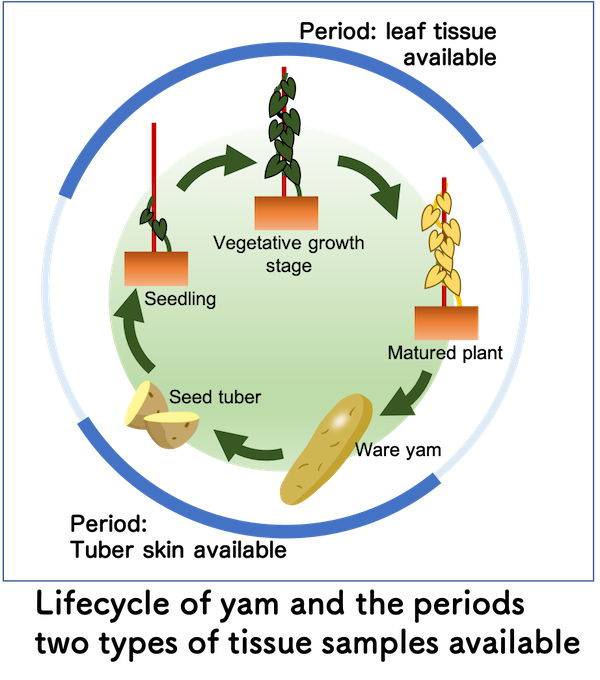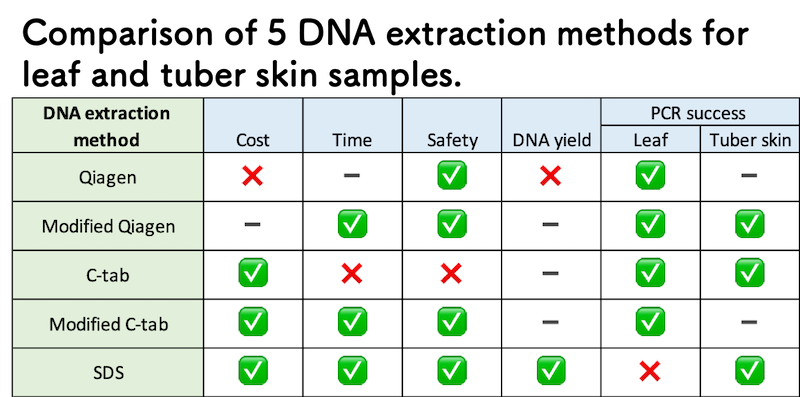Yam Variety Identification Toolkit: Step 2
Step2
In this step, you will learn how to obtain DNA sample from your target materials for variety identification.
The DNA quality of samples is key to obtain successful results for your analysis. Though the SSR marker system does not require ultra-pure DNA, how tissue samples are collected and preserved prior to DNA extraction affect the DNA quality.
To obtain quality DNA for analysis, the “Yam Variety Identification Toolkit” provides two recommended methodologies for tissue sample preparation and DNA extraction.
Tissue sample preparation and DNA extraction
Through the extensive examination, we nominated two best combination of "sample type" and "DNA extraction method" which could bring best result of variety identification. Currently “leaf sample” and “tuber skin sample” and best DNA extraction methods for each sample type are recommended for successful tissue sample preparation and quality DNA extraction of white Guinea yam.
Following sections provide the technical manuals for tissue sample preparation and DNA extraction using "leaf" and "tuber skin" samples. Also, two short movies (about 2 min.) are available for your better understanding of both "leaf" and "tuber skin" sample preparations.
- "Leaf" or "tuber skin" which sampleI should use? It is depend on your choice. Please see "Tips: Which, Leaf or Tsuber skin to be selected for sample collection?" section in below.
- If you want to check the characteristics of each DNA extruction method, please see "Qality DNA in safe, and time- and cost-effective manner" section in below.
How to extract quality DNA from leaf sample
How to collect leaf sample
- Leaf sample collection manual (PDF)
- Supporting movie of the leaf sample collection manual (Play on Yutube)
How to extract DNA from leaf sample
How to prepare tuber skin sample for DNA extraction
How to collect tuber skin sample
- Tuber sample collection manual (PDF)
- Supporting movie of the tuber skin collection manual (Play on Yutube)
How to extract DNA from tuber skin sample
Why using Silica gel for tissue sample collection?
For both sampling methods, “Dried silica gel” is used for sample drying. Though the initial cost for silica gel may not be negregiable, this method is still economical with below reasons:
- Silicagel can be recycled throught the heating process with clean pan.
- The sample dried in “Dried silica gel” can be preserved sometime at room temperature without refrigerator
- The sample can be shipped domestically and internationally with various courier service (Plant sanitary certificate may be required for plant quarantine purpose).
How to recycle silica gel
Silica gel can be recycled several time for the tissue sample preparation for DNA extraction, and reduce the cost drastically for tissue sample collection.
- Silica gel recycling manual (PDF) Under construction
- Supporting movie of the manual (Play on Yutube) Under construction
What is new for Yam Variety Identification Toolkit?
Wider choice of sampling period:
Guinea yam takes almost a year to complete its life cycle, and quick preparation of suitable tissue materials is difficult for various reasons, e.g., dormancy, low multiplication rate, etc. We propose two types of tissues, “leaf” and “tuber skin” for sampling and DNA extraction, which provide users with a wider choice of suitable sampling period within the lifecycle of yam.
Less material and low cost for field sampling:
The silica gel drying method is easy to use especially when the sample collection is conducted in the field away from lab facility. It does not require costly materials such as liquid N2 and dry ice, and it can be preserved for some time at room temperature without a refrigerator.
Quality DNA in safe, and time- and cost-effective manner:
The two methods for “leaf sample” and “tuber skin sample” proposed here enable users to conduct DNA extraction in a time- and cost-effective manner without the use of harmful chemicals and obtain good results.
Various combinations of tissue samples and DNA extraction methods have been compared on cost, time, safety (use of harmful chemical), DNA yield, and PCR success for various types of tissue samples to determine our recommended DNA extraction methods for Guinea yam. And, based on the result, two methods, “Modified C-tab method” for leaf sample and “Hara’s SDS method” method for tuber skin sample are nominated as shown in above table.
Tips: Which, Leaf or Tuber skin samples to be selected for DNA extraction?
Two methods for “leaf sample” and “tuber skin sample” can be selected depending on users’ requirements.
“Leaf sample” is effective to:
- confirm level of genetic purity during large field propagation
- identify varieties/lines of field grown plants
- obtain high quality DNA sample for genetic analysis
“Tuber skin sample” is effective to confirm variety/line before:
- seed tuber preparation for field operation
(e.g. crossing block, field multiplication, etc.)
- the analysis of tube quality of material collected from market
- shipping seed tuber materials to partners for sharing or market for sale
"Use case example" also help you to select best DNA preparation. Please click here to move to "Use case example" page.







